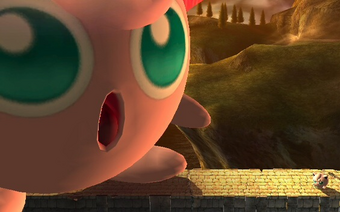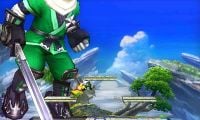Glitch: Difference between revisions
mNo edit summary |
m ("during when") |
||
| Line 2: | Line 2: | ||
:''For a list of all articles on glitches, see [[:Category:Glitches|Category:Glitches]].'' | :''For a list of all articles on glitches, see [[:Category:Glitches|Category:Glitches]].'' | ||
[[File:Jigglypuff glitch.png|right|thumb|The [[Regenerating terrain glitch]] in ''[[Brawl]]'' that makes Jigglypuff very large once after using its final smash | [[File:Jigglypuff glitch.png|right|thumb|The [[Regenerating terrain glitch]] in ''[[Brawl]]'' that makes Jigglypuff very large once after using its final smash when the bridge is reforming.|340px]] | ||
A '''glitch''' is an oversight of programming of a video game and how it may act in some circumstances. They alter [[gameplay]] by causing events or actions to occur that were not intended by the game's designers. The main reason for a glitch existing is that a specific situation resulting in unusual behaviour was never encountered during a game's testing, so the developers were unaware there was something that needed to be fixed. For example, the [[regenerating terrain glitch]] exists because the situation of "terrain appears around character using Final Smash" was not fully tested by the developers. The more complex a game is, the more likely gitches are to exist, simply due to the increased difficulty in testing every possible situation. | A '''glitch''' is an oversight of programming of a video game and how it may act in some circumstances. They alter [[gameplay]] by causing events or actions to occur that were not intended by the game's designers. The main reason for a glitch existing is that a specific situation resulting in unusual behaviour was never encountered during a game's testing, so the developers were unaware there was something that needed to be fixed. For example, the [[regenerating terrain glitch]] exists because the situation of "terrain appears around character using Final Smash" was not fully tested by the developers. The more complex a game is, the more likely gitches are to exist, simply due to the increased difficulty in testing every possible situation. | ||
Revision as of 12:46, February 20, 2015
- For a list of all articles on glitches, see Category:Glitches.

A glitch is an oversight of programming of a video game and how it may act in some circumstances. They alter gameplay by causing events or actions to occur that were not intended by the game's designers. The main reason for a glitch existing is that a specific situation resulting in unusual behaviour was never encountered during a game's testing, so the developers were unaware there was something that needed to be fixed. For example, the regenerating terrain glitch exists because the situation of "terrain appears around character using Final Smash" was not fully tested by the developers. The more complex a game is, the more likely gitches are to exist, simply due to the increased difficulty in testing every possible situation.
Effects that glitches cause can vary. Glitches can be harmful, with such side effects as freezing the game, causing a level to be unplayable, or KOing a player for no apparent reason. Not all glitches have negative side effects, however; some just allow the player to continue playing the game as usual, such as the Black hole glitch, while others can merely be done for fun, such as the Name Entry glitch and all of its variations. Some can even be considered helpful in some ways, such as the regenerating terrain glitch on Jigglypuff and R.O.B.
In competitive play, most glitches cannot be combined with a player's ordinary tactics in tournaments; a majority of glitches require prerequisites that are unattainable in a tournament setting, such as items, Final Smashes, more than two players, etc., or just simply have entirely useless effects. When it comes to the legality of performable glitches however that can have a practical effect, they are generally allowed to be used, as they are perceived to add to the afflicted characters' metagames, such as the Teleport in Smash 64 and Yoyo glitch in Melee. Glitches with only cosmetic effects can also be allowed in competitive play, such as Melee's stock glitch. However, glitches that break the game or otherwise cause matches to become unplayable for any party, such as by freezing opposing characters or making the user invincible, are universally banned from being used in tournaments; the Freeze glitch in Melee and the Infinite Dimensional Cape in Brawl are two such glitches that are banned in competitive Smash, and use of either of these glitches can potentially lead to the disqualification of the offending party.
Super Smash Bros. for Nintendo 3DS and Super Smash Bros. for Wii U are constantly updated with new bug fixes and features, meaning that glitches can be fixed as they are discovered. Version 1.0.4 for the 3DS version, for instance, fixed a glitch where characters could grow to immense sizes in Multi-Man Smash via the use of Yoshi's Egg Lay.
A glitch is not to be confused with an exploit, though the two terms can be hard to distinguish and are often used interchangeably. Exploits most commonly refer to mechanics and interactions that separately work as intended, but when combined, result in an unintentional effect. Wavedashing is one of the most prominent examples of an exploit. Glitches should also not be confused with an easter egg, which are intentionally added into the game as a bonus for players by the developers.
